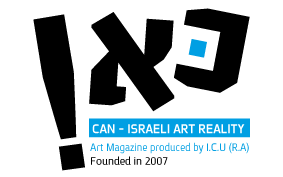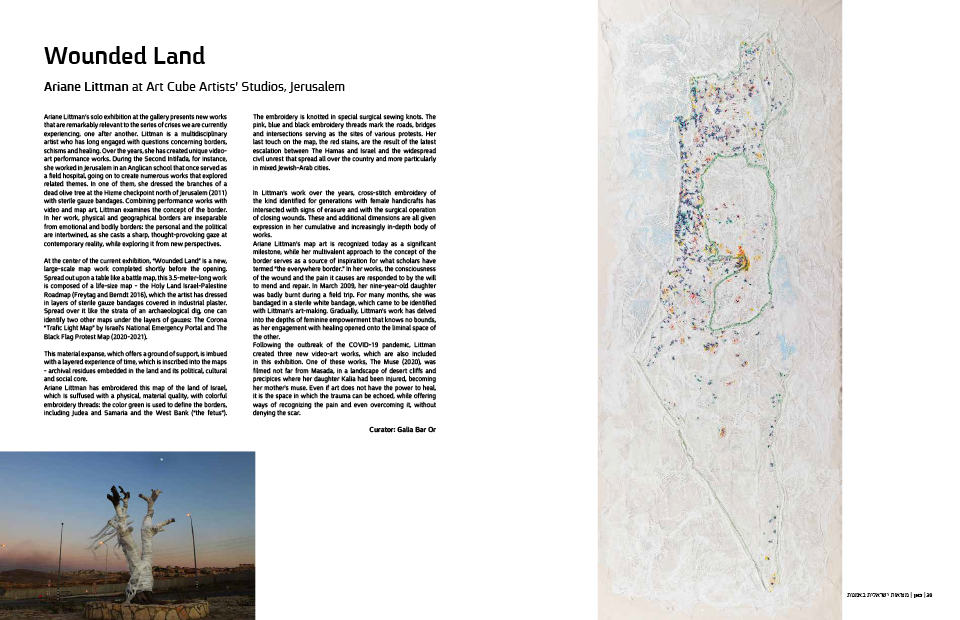
| Home Page | Editor Notices | Museums | Galleries | Publication | Donation | Contact Us |


 | |||||||||||||||
| |||||||||||||||


| |||||||||||||||
| Wounded Land / Ariane Littman at Art Cube Artists' Studios, Jerusalem |
Ariane Littman’s solo exhibition at the gallery presents new works that are remarkably relevant to the series of crises we are currently experiencing, one after another. Littman is a multidisciplinary artist who has long engaged with questions concerning borders, schisms and healing. Over the years, she has created unique video-art performance works. During the Second Intifada, for instance, she worked in Jerusalem in an Anglican school that once served as a field hospital, going on to create numerous works that explored related themes. In one of them, she dressed the branches of a dead olive tree at the Hizme checkpoint north of Jerusalem (2011) with sterile gauze bandages. Combining performance works with video and map art, Littman examines the concept of the border. In her work, physical and geographical borders are inseparable from emotional and bodily borders: the personal and the political are intertwined, as she casts a sharp, thought-provoking gaze at contemporary reality, while exploring it from new perspectives. At the center of the current exhibition, “Wounded Land” is a new, large-scale map work completed shortly before the opening. Spread out upon a table like a battle map, this 3.5-meter-long work is composed of a life-size map – the Holy Land Israel-Palestine Roadmap (Freytag and Berndt 2016), which the artist has dressed in layers of sterile gauze bandages covered in industrial plaster. Spread over it like the strata of an archaeological dig, one can identify two other maps under the layers of gauzes: The Corona “Trafic Light Map” by Israel’s National Emergency Portal and The Black Flag Protest Map (2020-2021). This material expanse, which offers a ground of support, is imbued with a layered experience of time, which is inscribed into the maps – archival residues embedded in the land and its political, cultural and social core. Ariane Littman has embroidered this map of the land of Israel, which is suffused with a physical, material quality, with colorful embroidery threads: the color green is used to define the borders, including Judea and Samaria and the West Bank (“the fetus”). The embroidery is knotted in special surgical sewing knots. The pink, blue and black embroidery threads mark the roads, bridges and intersections serving as the sites of various protests. Her last touch on the map, the red stains, are the result of the latest escalation between The Hamas and Israel and the widespread civil unrest that spread all over the country and more particularly in mixed Jewish-Arab cities. In Littman’s work over the years, cross-stitch embroidery of the kind identified for generations with female handicrafts has intersected with signs of erasure and with the surgical operation of closing wounds. These and additional dimensions are all given expression in her cumulative and increasingly in-depth body of works. Ariane Littman’s map art is recognized today as a significant milestone, while her multivalent approach to the concept of the border serves as a source of inspiration for what scholars have termed “the everywhere border.” In her works, the consciousness of the wound and the pain it causes are responded to by the will to mend and repair. In March 2009, her nine-year-old daughter was badly burnt during a field trip. For many months, she was bandaged in a sterile white bandage, which came to be identified with Littman’s art-making. Gradually, Littman’s work has delved into the depths of feminine empowerment that knows no bounds, as her engagement with healing opened onto the liminal space of the other. Following the outbreak of the COVID-19 pandemic, Littman created three new video-art works, which are also included in this exhibition. One of these works, The Muse (2020), was filmed not far from Masada, in a landscape of desert cliffs and precipices where her daughter Kalia had been injured, becoming her mother’s muse. Even if art does not have the power to heal, it is the space in which the trauma can be echoed, while offering ways of recognizing the pain and even overcoming it, without denying the scar. Curator: Galia Bar Or Read more  |
| all rights reserved - CAN ISRAELI ART REALITY |
| סייבורג מחשבים - בניית אתרים |